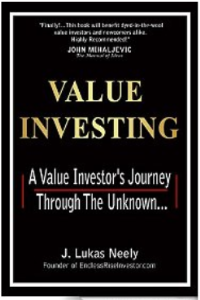Always Think About Risk Before Return
 *Excerpt from the new best selling book: A Value Investor’s Journey Through The Unknown…
*Excerpt from the new best selling book: A Value Investor’s Journey Through The Unknown…
“Focus on the downside, and the upside will take care of itself.”
Mark Sellers
Every great investor has one thing in common:
They think about risk before ever contemplating return.
Contrary to popular opinion, the greatest investors are extremely risk-averse. A great investor will always focus on risk first --- reward second. The majority of investment strategies and systems do not focus enough on risk and the probability of permanent capital loss. I only know of one such strategy, and that’s value investing.
There are only a few options you can use to help you decrease your risk: hedge or sell when appropriate, know your investment intimately, hold cash, invest in the “risk-free” rate, diversify to a certain extent, and of course invest with a margin of safety.
GOLDEN RULE: DON’T LOSE MONEY
1st Rule of Investing: Don't lose money.
2nd Rule of Investing: Don't forget the 1st Rule.
As many know, this statement was made famous by Warren Buffett, and I agree with him wholeheartedly. This is why I believe that investing in a risk averse manner is the best way to protect your capital and increase your wealth over the long-term.
Any permanent losses to your investments can wreak havoc on the beauty of compounding. Even compounding at very low rates can bring about massive success, so an investor’s focus should be on understanding the potential for permanent loss in any investment.
Of course this doesn’t mean you “never” incur risk…
First, we need to define risk. The definition of risk is an interesting topic altogether, but I define risk as the probability of permanent capital loss over several years. Fluctuations in stock prices do not constitute risk. The underlying business fundamentals, and its future prospects will determine what constitutes risk to an investor.
“Risk comes from not know what you’re doing.”
Warren Buffett
There is no hard-fast rule on how to eliminate risk completely. And because of that, the best way to mitigate risk is through an appreciable (and expanding) Margin of Safety in your Plan of Attack.
Here is my Plan of Attack:

We’re all human --- There is a speculative urge encapsulated in all of us.
The first step is to acknowledge it, and then move on to making unemotional and rational decisions. The idea of quick and easy money can sometimes be too difficult to pass up, but we must resist the urge. Speculative situations give market participants the greatest probability of risk.
That’s why a plan of attack (like the figure above illustrates) can keep us focused on the areas that matter most too investing success and our margin of safety.
I know it sounds counter-intuitive; however, avoiding risk is the best way to produce wealth over the long term. This is why we focus on the business fundamentals and a margin of safety.
There will be many times throughout your investing journey when you will be tempted by speculative ideas --- it’s only natural. Don’t give in to the temptation though. The market wants you to make these impulsive and speculative decisions.
Always search for free cash flow and protection in the form of assets to help decrease your risk in any investment, and always insist on a margin of safety.
It’s funny to me that the majority of investors think they need to incur significant risk to attain significant returns. If you are able to mitigate your losses, and compound your money steadily over time, your returns WILL be significant.
This brings us to another important topic…
Volatility ≠ Risk
Volatility is opportunity to an investor…Not risk!
In fact, we welcome volatility as long-term investors. However painful it may be in the short run, we know that volatility allows us to establish positions in high quality businesses or special situation opportunities that offer the highest probability of success.
Our view is that the market and its individual components are not efficiently priced ALL the time. Now realize I said, “Not all the time.” We are not believers in efficient market hypothesis (EMH), but we do believe the market does a fairly good job of valuing securities most of the time.
Our main issue with EMH is that it ignores tail risks and uncertain or unforeseen events.
And this would seem logical and rational at first glance. However, history and real world experience has proven repeatedly that you need to be prepared for the unknown. As a result, you need to expect the unexpected. And actually prepare to be wrong. This is why you want to position your portfolio in such a conservative manner --- Investors know they will eventually be wrong.
These times of uncertainty are welcomed. When the market over reacts to the upside or downside, it can create opportunities for long-term investors to take advantage of in a risk averse manner.
What’s Your Plan of Attack For Investing Success?




GOOD TO FOLLOW UP
Thanks for all the kind words and support! Enjoy!
Planning to pick up a copy of this. Thanks.
Looks like an interesting read, thanks for sharing.